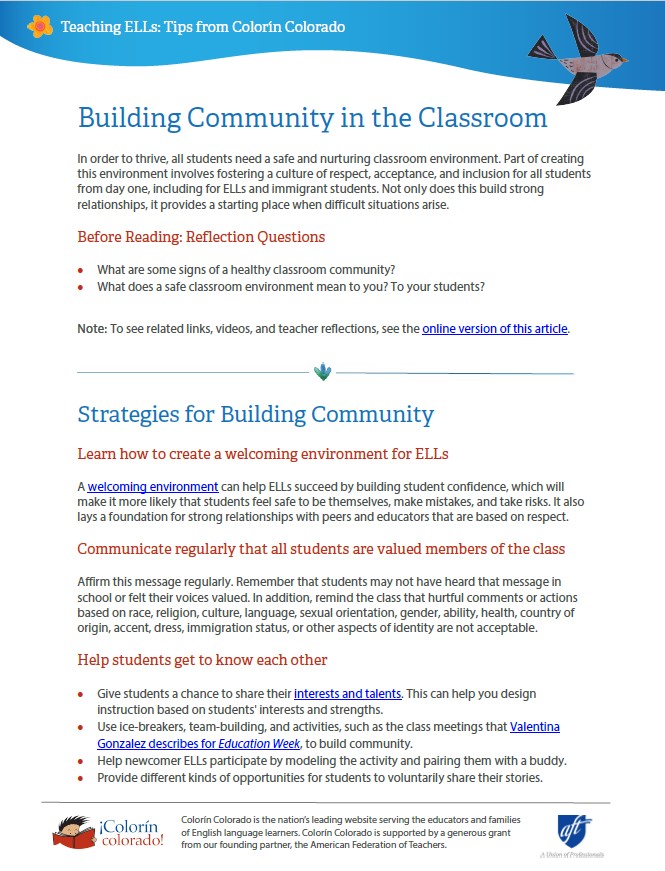When Conversations Take a Difficult Turn

Learn about some strategies you use when discussions in the classroom take a difficult or unexpected turn and how to manage conflicts that may arise. This article is part of Navigating Tough Topics in the Classroom: Tips for ELL Educators.
Acknowledgements
 This project was made possible with support from the American Federation of Teachers.
This project was made possible with support from the American Federation of Teachers.
Photo credit: Photo by Allison Shelley
Sometimes, despite your best intentions and careful planning, classroom conversations move into difficult territory. Here are some strategies for managing those moments, along with some recommended resources.
 Before Reading: Reflection Questions
Before Reading: Reflection Questions
- What's a step you can take in the near future to prepare for difficult conversations?
- What's an issue this article raises that you would like to further explore?
Responding in the Moment
Before stepping in, ask yourself if students can handle it
Consider whether you think the students in the room have the tools they need to work through the discussion. They may surprise you and speak up for the class’s shared values.
Stop disrespectful or hurtful behavior and speech immediately
If the conversation is moving into the territory of insulting language, stereotypes, or hate speech, or if students in the room are personally troubled or offended by the direction of the discussion, stop the conversation immediately. Your students will be watching your response. Some phrases you might use in response are:
- “Let’s pause and remember our class guidelines. We want everyone to feel safe in our classroom. I’m betting that not everyone feels safe right now.”
- “Are you aware you said something hurtful when you said that?”
- “What did you mean by that?” Follow up with “Tell me more” or “Help me understand.”
- “Using that word doesn’t help others feel safe or accepted here.” (Learning for Justice)
Be calm, consistent, and firm
- Keep students’ well-being at the center of your attention.
- Stay open to points of view that differ from your own, and don't escalate the situation based on your own feelings and fears.
- Don’t single students out, especially based on their identity.
- If you have established shared guidelines or values for your classroom, remind students of those guidelines.
- Reiterate that while everyone has a right to express themselves, that right is accompanied by the responsibility to do so respectfully.
- Don’t be afraid of silence.
- Don’t hesitate to shut the conversation down if needed. You have veto power.
- You may wish to take a break and have students turn to a journal writing activity where they can process what has been said privately.
- Use your safety valves — opportunities to stop, take a breath, reflect, and perhaps share personal reactions after some time has passed. These might include the use of graphic organizers or brief activities for addressing stress. If there is some tension, use these tools as a way to pause and reset.
- Determine whether to continue the lesson or pause it until the next day and move onto something else.
Kristina Robertson writes, "Try not to underestimate the value of listening and accepting silence. I find many teachers are afraid of silence or challenging moments because they don't want to lose control or feel the need to rescue students."
Don’t minimize students’ fears or feelings
When students share their concerns, fears, or feelings, don't dismiss them or assure them that "everything will be fine." You may wish to follow up with them privately after class and express your support or offer ways for students to express themselves anonymously, such as posting sticky notes on a board.
If students are withdrawing or acting out, take a step back and ask why
Rather than putting students on the spot to try to engage them, ask yourself if this conversation may be making them uncomfortable or angry. Follow up with them individually after class to check in and see if there is a way to address their feelings. Remember that every behavior is a form of communication.
After the Incident
Reflect on the incident
Return the next day to debrief the situation after you have prepared a protocol to respectfully discuss what happened and how it made people feel. Consider a restorative circle approach. It’s important that students understand how to protect their community, support each other, and return from a negative experience.
- Consider whether you have created a safe space.
- Use this as an opportunity to revisit or establish a classroom community based on respect.
- Take a step back and remind yourself of the objectives of the lesson — what did you want to accomplish with this lesson? How can you get back on that track?
- Discuss your concerns with a trusted colleague who can give you constructive feedback.
Following a difficult conversation, keep eyes and ears open around the school
Students are likely to repeat what has happened if things got heated or tense. Keep an eye out to make sure that this is not creating an uncomfortable situation for other students or leading to any bullying. You may wish to give your administrators a heads up about the situation.
Determine whether you need to…
…meet privately with students
If students indicate that they are upset or personally impacted by difficult events that are part of classroom discussion or by the discussion itself, check in with the students privately after class. Reassure them that they can speak to you or a guidance counselor whenever it’s needed and ask if there is something that you or the class can do to help provide some support.
You may also need to meet with students who engaged in the hurtful comments or behavior. Keep in mind that there may be more to the story.
...alert social workers or counselors about the incident
You may need to alert a social worker/counselor about what has happened and ask them to meet with the student(s) when you realize that the situation requires someone with more expertise or the situation has been escalated and requires mediation or intervention.
…address the incident the following day
Would it be helpful for students to discuss and process the events of the previous day, or is it more productive to continue with the lesson? If students are likely to bring it up themselves, it may be worthwhile to spend some time on it as a class before moving on.
…alert administrators or families of what occurred
You may need to notify administrators of what has happened. Ask your administrators for guidance on next steps as needed and whether families need to be notified, or follow-up communication should come after students have shared what has happened with their families. You can also talk to your building union representative if you have additional questions.
Defusing a Power Struggle
Despite all of your best efforts, you still might find yourself in a power struggle with a student. Susan Lafond suggests the following approach:
When students attempt to engage other students or adults in a power struggle, they extend “hooks” meant to lure the person into a negative cycle of behavior. A hook may be:
- verbal (words or language the student knows will upset the person)
- non-verbal (a “look” or a gesture)
- an action (e.g., “playing” to an audience to gain allies)
To avoid being pulled into the student’s intended cycle of hostility, there are a number of actions you can take.
1. Recognize and ignore hooks.
2. Respond to students calmly and confidently.
- Maintain eye contact.
- Maintain privacy and proximity, keeping the situation between you and the student.
- Use any preferred strategy to remain calm, e.g., counting to 10, taking slow, deep breaths, etc.
3. Actively listen to the student.
- Try and see the student’s point of view.
- Look for the “brighter, positive” aspects of the student’s behavior.
- Use defusing statements, such as ‘Let’s take a five-minute break’, ‘Let’s table this discussion for tomorrow’ or ‘Let’s all take a deep breath.’
4. Recognize the situation and what is happening. Let the student know when the situation is escalating and what the risks are if this should continue, including the impact on other students, the classroom community, and other consequences resulting from classroom or school rules.
5. Select an acceptable alternative to the escalating behavior.
- Walk away.
- Take a cooling-off period — for student and/or adult — with the discussion to be continued.
- Give student a “choice”: behavior change or ending the activity, or if the situation escalates, removal from the classroom.
- Seek help and support, if needed.
- Offer the student the opportunity to reflect on the interaction privately in a journal or in a follow-up conversation with you or another colleague. While the student may not wish to engage with you or anyone else, some extra time and attention may provide an opportunity for further discussion or explanation about an issue that is troubling the student.
What To Say When You’re Confronted
Using Defusing Statements
What we say when confronted with outbursts of hostility or aggression from students can determine the resolution of the situation — whether it is resolved quickly and calmly, or whether the conflict is escalated. Look for opportunities to say, “Yes, and…” to demonstrate that you can accept some of what the student is saying and you want to move in a different direction. The statements below are examples of adult responses that do not “buy into” disruptive student behaviors:
- “What you’re saying may be true. I care about what you have to say, though it’s hard for me to hear you when you use disrespectful words.”
- “I understand what you’re saying. I see things differently. Let’s talk about our differences with a teacher or counselor.”
- “I’m disappointed you’re choosing to use such hostile words. It makes me feel I have to defend myself. We can find a solution if we use respectful words.”
Give kids a situation and let them role play. The idea is to practice using the language so when the time comes they can return to this experience and use what they practiced. So often we have a visceral response and always do what we have always done (which is ineffective). By creating a “new memory” through practice, when the situation occurs, the students have a better chance of using the diffusing statements in the heat of the moment.

